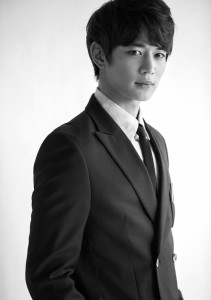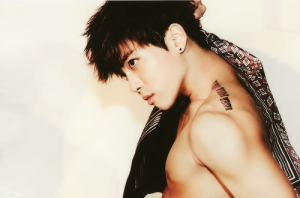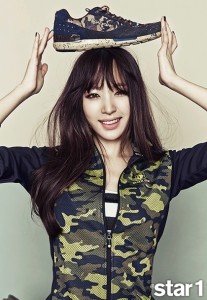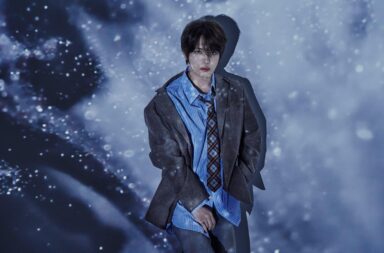 During our month of crazy March Madness, we’ve had roundtables discussing rapping, dancing and singing. It only makes sense that we’d end the month by talking about the most unique of the idol categories: The Visual.
During our month of crazy March Madness, we’ve had roundtables discussing rapping, dancing and singing. It only makes sense that we’d end the month by talking about the most unique of the idol categories: The Visual.
Unlike the other roles in a group, the visual is a much more subjective role. So instead of asking the question of what makes a visual “good,” we are going to get a little more deep with this discussion.
Our question for the week is: Why is there a “Visual” category? What purpose does the “Visual” serve in a K-pop group? Is being attractive all there is to it?
Rachel: Apart from being attractive, the visual is almost like a mascot for the group. It’s their job to get attention for the entire group with their looks and personality. I think that they are more limited in what they can do and how much personality that they can show because they have to be the ideal type and set the standard for everyone else. The other members can be sillier, shy, etc. Having a visual can also mean more exposure for the group because he or she is often invited to do the dramas, fashion shoots, etc. If people like one member they become ore curious about the others.
Camiele: I got into K-pop a little bit later than most here. The first group I was introduced to was DBSK. Thus when I learned the term “visual,” it was with Jaejoong as my example. I found out the phrase “visual shock” was coined because of Jaejoong, which makes sense, considering one of the first things he ever got recognized for at SM was how he looked. So my understanding of a visual is someone with a face so unique it’s just shocking. A face that’s more than just “pretty.” It’s, in fact, so different it’s either thought of as a work of art or something completely hideous — descriptions that Jaejoong has gotten for his face since he debuted.
 That’s why some of the idols considered the groups’ “visuals” confuse me. For instance, in Shinee, Minho is considered the visual, but his features are pretty standard for a pretty idol. I initially thought Jonghyun was the visual because while he’s also a main vocal (as Jaejoong was), his features are just so different and visually jarring. This is what I think of when I think of a visual.
That’s why some of the idols considered the groups’ “visuals” confuse me. For instance, in Shinee, Minho is considered the visual, but his features are pretty standard for a pretty idol. I initially thought Jonghyun was the visual because while he’s also a main vocal (as Jaejoong was), his features are just so different and visually jarring. This is what I think of when I think of a visual.
As far as the visual’s role, as Rachel said, at first Jaejoong’s role was really as the mascot. He wasn’t even allowed to talk for the first two years after DBSK debuted. “Just stand there and sing,” were his instructions. But as far as I’m concerned, Jaejoong broke that mold as soon as he was allowed to talk on variety shows. The fact he was the lead vocalist and the group’s visual, and even impressing Yoo Jae-suk enough to want him on his shows regularly, sort of changes the idea of visual as “silent, pretty-faced mascot” into “overall representative” of a group.
Taylore: I’ve always heard that a visual’s job is to attract people to their group. In the case of EXID‘s Hani, she seems to have done her job quite well. The huge response she triggered with her “Up and Down” fancam had more to do with her dancing than simply with her looks, which I think speaks to the importance of a “visual” member’s ability to draw attention by appealing to people’s eyes with more than just a pretty face. A lot of times, it isn’t even the visual who helps bring attention to a group at all, and the visual just seems to be dead weight (or they get turned into rappers…I’m looking at you, Minho).
On a more personal level, I can say that I have fallen prey to the charms of a “visual,” namely B1A4‘s Gongchan. I was first attracted to the group because of Gongchan’s looks, and though I have since picked another member as my bias, the fact stands that I wouldn’t have ever looked at B1A4 if it wasn’t for their visual.
 Cjontai: The visual role was the most perplexing thing for me to understand when I got into K-pop. I didn’t understand the purpose of assigning someone to be the most attractive member. That’s such a subjective thing. Who determines the levels of hotness among the members? What if fans disagree with that title? Won’t it hurt that member and the group?
Cjontai: The visual role was the most perplexing thing for me to understand when I got into K-pop. I didn’t understand the purpose of assigning someone to be the most attractive member. That’s such a subjective thing. Who determines the levels of hotness among the members? What if fans disagree with that title? Won’t it hurt that member and the group?
In the U.S., visuals do play a role in how people envision a celebrity, and we usually refer to that as an “it” factor. It’s a natural animal attraction that draws in people. However, as more idols become recognized for actively participating in the production of their albums, it feels like the role of visual becomes less essential. If that person is unable to gain fans, then his/her role becomes more confusing because fans ask why that person was even cast in the group.
Personally, I’d be okay if the visual role disappeared because it doesn’t seem to help the group in the long run. Let’s take miss A‘s Suzy for example. Sure, her role helps her gain fans, but does it truly help her group as a whole? When people think of miss A, they generally think of Suzy first, but that’s where it stops. They may not know their songs, but they’ll remember seeing Suzy in a commercial or drama. It doesn’t guarantee an interest in the group, which is where the role of a visual fails. Fans can fawn over her beauty, but if they’re not buying miss A’s albums, then who cares?
Andy: I think the “visual” comes in two forms. The most common is simply the member with the standard ideal look or the unusual, but striking features. When someone says “visual,” my first instinct is to ask if they are former ulzzangs. These members serve as a good-looking face to draw attention to the group. The second form is less focused on physical beauty and more focused on their visibility. They don’t have to be the best looking member, but they have the types of personalities and aura that simply attracts attention.
 Sometimes, the “visuals” are rather sub-par in terms of talent, but I don’t think they are completely useless. They do serve to attract attention to the group, and sometimes they are excellent in variety or acting. If your group is struggling to gain some mass attention even though your music is good, the visual can become very important to any long-term success. The biggest qualm with the whole “visual” idea is that often a group simply becomes “pretty person and those other people with her/him.”
Sometimes, the “visuals” are rather sub-par in terms of talent, but I don’t think they are completely useless. They do serve to attract attention to the group, and sometimes they are excellent in variety or acting. If your group is struggling to gain some mass attention even though your music is good, the visual can become very important to any long-term success. The biggest qualm with the whole “visual” idea is that often a group simply becomes “pretty person and those other people with her/him.”
Mark: I think we’re overthinking this. A visual is there to look good and hog the camera. If an idol manages to be popular yet not be particularly good at any one performance skill, then he/she gets labelled a “visual” in order to justify said idol’s role in the group. Yes, a visual can act, go on variety, and do whatever is needed to draw attention to the group but at the end of the day, they all share one thing in common: they’re lacking in the talent department. Otherwise, we wouldn’t call them “visuals;” we’d call them rappers, vocalists, or dancers. Unless you consider looking good to be a talent, because it certainly is!
Camiele: I think that may be selling the actual visuals short. That may be the shorn down definition of it; however, that discounts those idols who actually serve a larger role in the group… who are still called visuals. I suppose I’m going on people who actually do more than just stand there and look pretty: Jaejoong, Minho, Eric from Shinhwa. All of them have versatile roles in their groups, and they’re definitely talented beyond just “looking good and hogging the camera.” So while the visual by definition is the one that stands out, as far as I can tell from the groups that I follow, there’s an added dimension to them that goes beyond the superficial.
 Hania: The visual category used to confuse me to no end, because as far as I was concerned, every idol was drop dead gorgeous. Of course, it soon became evident that every group has one particular stunner that reels the public in. Sometimes the visual is a very traditionally beautiful person, like Suzy, or sometimes, like Camiele mentioned, the visual is someone who has such a startling type of beauty that they divide audiences. Here, we can think of examples like Jaejoong or Kai, who have a striking, unique type of beauty (as well as bucket loads of talent when it comes to singing or dancing). These people may prove divisive among the public consensus, but the point is that they still succeed in drumming up hype about the group with their appearances.
Hania: The visual category used to confuse me to no end, because as far as I was concerned, every idol was drop dead gorgeous. Of course, it soon became evident that every group has one particular stunner that reels the public in. Sometimes the visual is a very traditionally beautiful person, like Suzy, or sometimes, like Camiele mentioned, the visual is someone who has such a startling type of beauty that they divide audiences. Here, we can think of examples like Jaejoong or Kai, who have a striking, unique type of beauty (as well as bucket loads of talent when it comes to singing or dancing). These people may prove divisive among the public consensus, but the point is that they still succeed in drumming up hype about the group with their appearances.
The visual sets physical standards that makes the group even more easy to idolise and to obsess over. As weird of a concept as it is, in the scope of K-pop, it makes total sense to have this figurehead of beauty that gets people staring and talking.
(Images via C-JeS Entertainment, SM Entertainment, Nylon, @star1, Shinhwa Company and Harper’s Bazaar)


